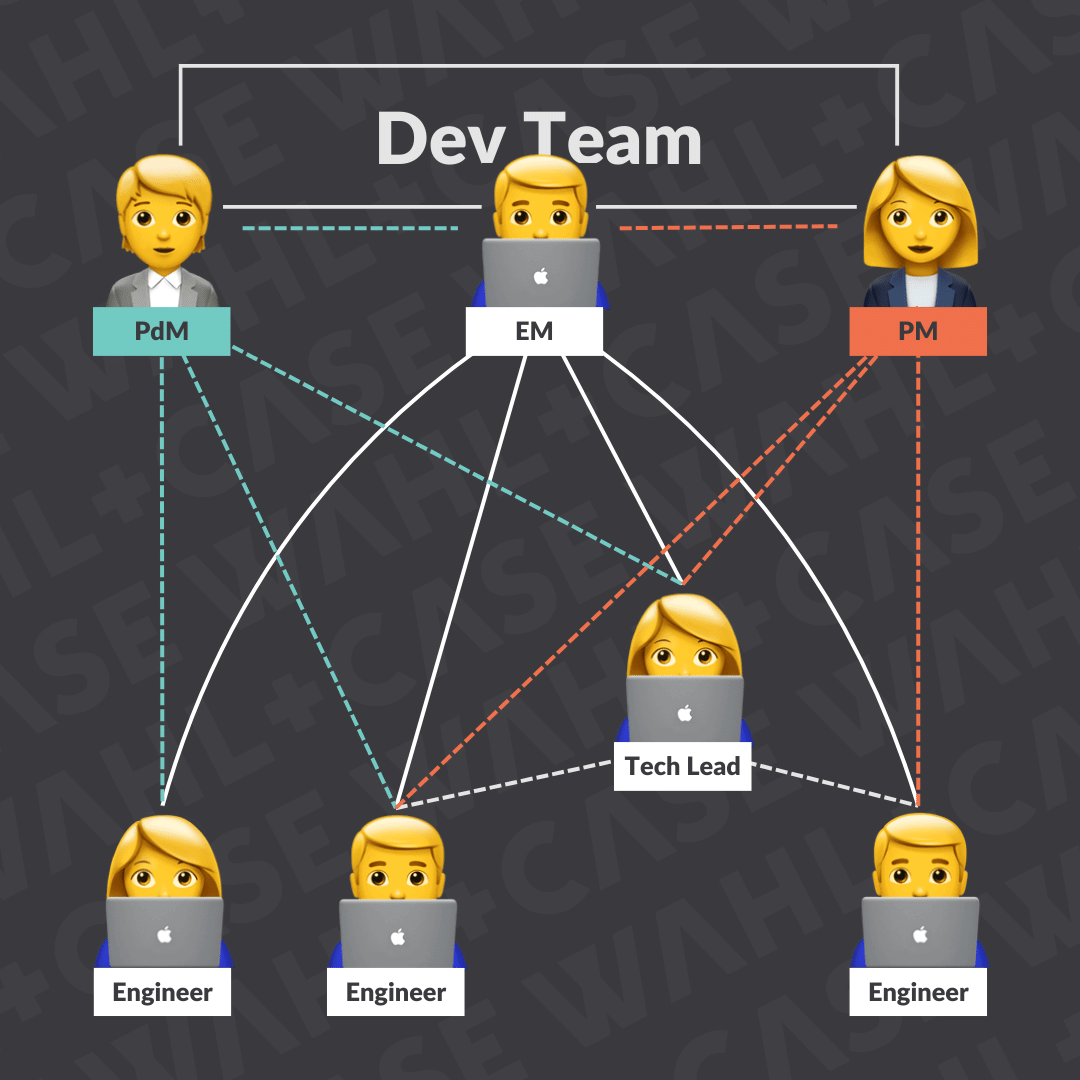How to Level Up from Engineer to Project Manager
She hated being an engineer.
That’s how Taylor started the story.
Taylor Wiles is a Senior Community Specialist at Wahl+Case, a technical recruiting firm in Japan.
I asked her about how to move from being and Engineer to being a Project Manager.
She speaks with engineers, project managers, product managers, and all manner of technical jobseekers in Tokyo.
This is what she looks like.
Now you can imagine she is telling you the story.
She gave me the inside scoop on what it takes to make the move as well as strategies on how to do it, tips for Japan specifically, and a warning to engineers looking to make this career shift.
But first, she told me this story.
How Taylor’s Friend Moved from Dev to PM
Taylor has a friend.
Let's call her “Taylor's friend.”
Taylor’s Friend graduated with a degree in computer science in Taiwan.
She moved to Japan right after university for work.
She had been studying Japanese during her university years, which opened the career doors for her when she landed in Japan.
She also spoke English.
The company she joined was a pre-IPO tech startup, she was working on the development team.
It was then that the first conflict arose.
Talyor’s friend she did not like development work.
Pause for gasps.
To overcome this distaste for the mundane, she switched to teaching machines to learn as a machine learning engineer.
Everything was moving smoothly, the machines were learning and the development was being developed.
However, she was yet again unfulfilled in her work.
Gasp, Gasp.
Let’s pause here.
It is worth going over the structure of a development team.
Engineering Team Structure
As an engineer, you'll be working closely with Project Managers (PM), Product Managers (PdM), and an Engineering Manager.
There is also an opportunity for an ambitious engineer to take on additional responsibilities in the role of a Tech Lead.
So the structure of a dev team looks like this:
In small companies, engineers often have to step up and handle additional responsibilities.
At larger companies, this is not as common.
To recap (this will be important in 5 lines):
Small company means you must take on responsibilities outside your Job Description.
Large company means you have to ask to take on those responsibilities.
We shall continue now with our piano interlude.
Back to the Story
Our protagonist has been working in development, but she can feel there is something missing from her life.
Like the dues ex machina we all dream of, there was a call for someone to take on PM responsibilities.
Taylor's Friend raised her hand and began project managing a feature project within the ML domain.
This awakened the piece of her that was missing.
She wanted to manage the team, use her knowledge to help people with their work, and make an impact on the project.
Within a year or two, she landed a PM role at a larger company.
Applause, and curtain.
This is a common route for you to make the move to PMing, and there were several things that helped Taylor’s Friend to stand out.
Here is Taylor’s analysis of what allowed her to land this job.
What Made Her Standout?
Language Skills
One of the key factors that made Taylor's friend stand out was her language proficiency. Being trilingual, she could seamlessly communicate in Japanese, English, and Taiwanese, which is a valuable skill in the tech industry in Japan.
Why This Matters:
Internal Communication: She could effectively communicate with both local Japanese team members and international colleagues, ensuring smooth collaboration and understanding.
Client Relations: Her ability to converse in multiple languages allowed her to handle diverse client interactions, which is crucial for project success and client satisfaction.
Documentation: She could read, write, and understand technical documents in Japanese, which is often a requirement for managing projects in Japan.
Strong Engineering Background
Her solid engineering background, especially in machine learning, provided her with a deep understanding of the technical aspects of the projects she managed.
Why This Matters:
Domain Knowledge: She had a comprehensive understanding of the full lifecycle of the projects, from development to deployment. This allowed her to make informed decisions and provide valuable insights.
Technical Credibility: Her engineering experience gave her credibility among her peers and team members, which is crucial for gaining their trust and respect.
Problem-Solving: With a strong technical foundation, she could effectively troubleshoot issues, understand the complexities of the work, and provide realistic timelines and solutions.
Already Doing PM Responsibilities
Before officially transitioning to a PM role, she was already taking on PM responsibilities. This gradual shift allowed her to build the necessary skills and experience.
Why This Matters:
Smooth Transition: By gradually taking on more PM tasks, she was able to smoothly transition into the role without a steep learning curve.
Experience and Skills: She was able to develop and hone essential PM skills, such as project planning, task delegation, and stakeholder communication, while still in her engineering role.
Proactive Attitude: Her willingness to take on additional responsibilities showcased her proactive attitude and readiness for the PM role, making her an attractive candidate for the position.
As I said before, this is not an unusual course for becoming a project manager after being an engineer.
Let’s look at the map of this path:
A Typical Path from Engineer to PM
Step 1: Starting as an Engineer
Your journey begins as an engineer within your company.
At this stage, you focus on developing technical skills and gaining experience in your field.
Responsibilities:
Developing software, features, or products.
Collaborating with other engineers and team members.
Participating in code reviews and development cycles.
Step 2: Becoming a Team Lead
The next step is to become a Team Lead.
This role is often a bridge between engineering and project management, providing an excellent opportunity to develop PM skills.
What is a Team Lead?
A Team Lead acts as a mentor for junior team members.
Communicates with other stakeholders and cross-functional teams.
Manages the development process, assigns tasks, and ensures their completion.
Responsibilities:
Leading the engineering team and overseeing project development.
Managing team tasks and workflows.
Mentoring junior engineers and helping them grow.
Communicating project updates and progress to stakeholders.
Why This Step is Important:
It allows you to practice leadership and management skills.
It provides experience in handling responsibilities similar to a PM.
It positions you as a key player in your team and prepares you for a formal PM role.
Step 3: Taking on PM Responsibilities
As a Team Lead, you begin to take on more project management responsibilities. This can happen naturally as you handle more tasks related to planning, coordination, and communication.
Responsibilities:
Planning project timelines and milestones.
Coordinating between different teams and departments.
Managing project resources and budgets.
Ensuring project goals are met and stakeholders are satisfied.
How to Succeed:
Be proactive in taking on additional responsibilities.
Communicate effectively with your team and stakeholders.
Develop your skills in project planning, task delegation, and problem-solving.
Step 4: Transitioning to a Junior PM Role
After gaining experience as a Team Lead, you can transition to a formal Project Manager role. Start with a junior PM position where you continue to develop your skills and experience.
Responsibilities:
Managing projects from start to finish.
Leading project planning and execution.
Coordinating with cross-functional teams and stakeholders.
Ensuring project deliverables are completed on time and within budget.
Why This Step is Important:
It formalizes your role as a PM.
Provides opportunities for further growth and development.
Allows you to take on larger and more complex projects.
You Need Japanese and…
In Japan, language ability is crucial. Especially for Project Managers.
You don’t need to be fluent, but you will need the ability to read and write technical documents as well as participate in meetings with all stake holders. These stake holders include internal and external partners and your team.
Having another language such as English, Chinese, or Vietnamese is valuable because of the off shore development teams you will be interfacing with.
There are roles that can be handled only in English or other languages, but these are rare.
Things to Keep in Mind
Small Team Advantage: In a small team, you might naturally take on more responsibilities because there are fewer people.
Big Team Support: In a large team, you can ask for additional responsibilities because there's a bigger safety net.
A Warning
Transitioning to a PM role means you won't be doing development work anymore.
If you want to stay close to development, consider becoming a Team Lead or Engineering Manager.
But if you're ready to move away from dev work, project management will great fit for you.
Ready to become a Project Manager in Japan?
Message us using this link to find out what PM jobs are open in Tokyo.
The next step
As a PM you are a conduit for targets, requirements, and information. Moving it to the appropriate places.
You will not be making decisions about the product strategy.
If you want to have impact on the direction of the product, you should become a Product Manager, find out how here.























